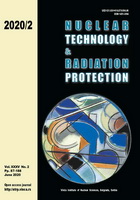
A COMPUTATIONAL METHODOLOGY FOR ESTIMATION OF AEROSOL RETENTION IN A SAND-BED BASED FILTERING SYSTEM FOR SEVERE ACCIDENT VENTING STRATEGIES
Pages: 87-94
Authors: Delfina Cuevas-Vasquez, Eduardo Sainz-Mejla, Javier Ortiz-Villafuerte
and Roberto Lopez-SolisAbstract
A computational methodology to estimate the capacity of aerosol particle retention in a filtering system based on sand bed is described in this work. This methodology uses a combination of computational fluid dynamics and mechanistic models in the calculation procedure. The methodology is applied to venting actions during a severe accident in a BWR Mark II primary containment. The SALOME and OpenFoam platforms were used to generate the geometric and numerical models of a full scale model of a sand bed filtering system. The Eulerian/ Lagrangian approach was used to determine the steady-state of a compressible turbulent flow through a porous media and to compute the aerosol particle transport, respectively. Collection efficiency was calculated by means of a mechanistic model based on the capture efficiency of a single grain. The obtained Eulerian results include velocity, pressure, and temperature fields inside the filtering systems. The Lagrangian tracking of aerosol particles showed that particles crossing the coarser sand tend to accumulate initially on the periphery of the filter. The parametric studies showed that mass-flows of up to 4.7 kgs-1 satisfy the constraint of 1.1 bar pressure drop across the sand depth. Additionally, the efficiency of 99.5 % of retention was determined for 1.0 µm aerosol particles in the 0.6 mm sand grain zone, for a gas velocity of 0.1883ms-1.
Key words: Mark II, severe accident, openfoam, SALOME, aerosol, filtering system, efficiency
FULL PAPER IN PDF FORMAT (954 KB)
